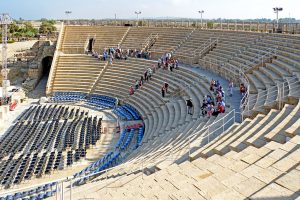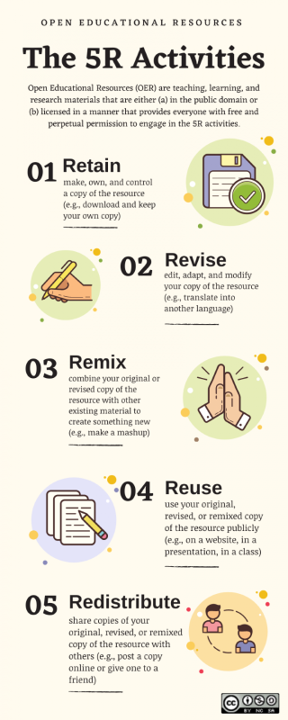Open Educational Resources (OERs)
Katya Henry; Kate Nixon; and Sarah Howard

“Open Education Resources (OERs) are educational materials which are licensed in ways that provide permissions for individuals and institutions to re-use, adapt and modify the materials for their own use. OERs can, and do include full courses, textbooks, streaming videos, exams, software, and any other materials or techniques supporting learning.” – OER Foundation definition.
Getting started
Open Educational Resources (OER) are teaching, learning, and research materials that are either 1) in the public domain, or 2) use open licences such as Creative Commons licences to make the content publicly available. Open licences preserve the creator’s intellectual property rights while giving permission for the material to be used, subject to certain defined conditions.
Watch this video “Open Education Matters: Why is it important to share content?” by Nadia Mireles
For an OER to be truly ‘open’ it should be licensed in such a way to allow for the 5R activities: retain, revise, remix, reuse, redistribute (David Wiley, https://opencontent.org/definition/ CC-BY).

Why use OERs?
Open educational resources have many benefits for learners and teachers, including :
- Improved student learning outcomes
- Increased access to teaching and learning resources
- Enhanced access to learning.
(See Reasons to use Open Educational Resources | The Open Education Consortium)
The 2017 Universities Australia Student Finances Survey found that one-third of university students have estimated expenses that are greater than their income, and that some groups of students are more likely to experience financial hardship. The survey reported that one in seven students regularly went without food or other essentials. The impact of COVID-19 has only made things worse for many student groups. To help manage the cost of university study, students may purchase an older edition of a textbook, they may delay purchasing a textbook or may never purchase the textbook, they might share the textbook with other students or download textbooks illegally from the internet. Textbook unaffordability affects student outcomes and has an adverse academic impact.
The use of OERs can have a positive impact on equity, student retention, and academic performance. See ‘Adopt, Adapt, Create’ below for details on how the use of OERs can benefit your learners.
Australian Open Textbooks as Social Justice
In an Australian first, Deakin University’s Australian Open Textbooks as Social Justice project examines the impact of open textbooks on social justice outcomes for learners. The research study poses the following questions:
-
- To what extent are Australian academics ready to embrace open textbooks as widening participation initiatives as seen in the USA, Canada and the UK?
- Can a social justice approach to open textbook initiatives in Australia deliver financial and motivational study benefits to students and a stronger sense of belonging for under-represented and disadvantaged students?
- How can Australian higher education institutions use open textbooks to redress educational injustices for Indigenous students?
To receive updates on the project’s findings, subscribe to the blog by contacting Sarah Lambert.
 Exercise: The use of Open Educational Resources supports the United Nations’ Sustainable Development Goals, and in 2019 the UNESCO OER Recommendation was adopted. On their mandate in OERs, UNESCO writes, “universal access to information through high quality education contributes to peace, sustainable social and economic development, and intercultural dialogue.” Check out UNESCO’s site on Open Educational Resources and discover how the use of OERs support learning during the COVID-19 crisis.
Exercise: The use of Open Educational Resources supports the United Nations’ Sustainable Development Goals, and in 2019 the UNESCO OER Recommendation was adopted. On their mandate in OERs, UNESCO writes, “universal access to information through high quality education contributes to peace, sustainable social and economic development, and intercultural dialogue.” Check out UNESCO’s site on Open Educational Resources and discover how the use of OERs support learning during the COVID-19 crisis.
Learn more
Adopt, Adapt, Create
There are a number of different ways you can incorporate OERs into your teaching practice.
- Adopt: Repositories collect OERs across all disciplines which you can freely reuse, including articles, textbooks, websites, lesson plans, activities and assessments. Take a look at ‘Where to find OERs’ below to understand the range of materials available to you.
- Adapt: OERs can be adapted and modified to create localised, customised content to meet the specific needs of learners. You can also combine resources or simply use part of an OER, you could add chapters or activities to existing content, or change examples to be directly related to your learning and teaching context.
- Create: Develop your own OER! The type of resource you create is only limited by your imagination. You can share your OER in existing repositories with an appropriate Creative Commons licence.
For guidance, see the University of Edinburgh’s resource on What to consider when creating an OER.
 Consider: How would you adapt an OER to benefit your students’ learning?
Consider: How would you adapt an OER to benefit your students’ learning?
Where to find OERs
- OER Commons – OER Commons is a repository of open educational resources from around the world. Users can search for content as well as share content.
-
- Explore the resources available within OER Commons. Use the educational level filter to help narrow your search.
- The Open Textbook Library contains over 900 open textbooks that can be freely downloaded and adapted. You can find textbooks from many disciplines, including Business, Humanities, Law, Medicine, Natural Sciences, Student Success and more. Around 60% of the OTL’s textbooks have been reviewed.
-
- Check out the University of Southern Queensland’s resource, Academic Success.
- OpenStax contains not just peer-reviewed open textbooks, but a huge variety of complementary Open Educational Resources that can be freely used and adapted. An initiative of Rice University, OpenStax textbooks are used in 60% of colleges and universities in the United States, and in over 100 countries.
 Exercise: Browse through one of the sites listed above and select a resource that you could adopt or adapt for your own institution.
Exercise: Browse through one of the sites listed above and select a resource that you could adopt or adapt for your own institution.
Challenge me
QUT supports the adoption, adaptation, and creation of OERs, and subscribes to the Pressbooks publishing platform to support this. Contact your Liaison Librarian for assistance in using Pressbooks.
 Exercise: Adapt the OER you found to suit the needs of your students. You might like to update the content to include most recent developments. You could include contextualised local content, including case studies, for example. Or you could include material that addresses Indigenous perspectives. Consider adding interactive content, including multimedia resources, such as videos, or use H5P to add quizzes to check for comprehension.
Exercise: Adapt the OER you found to suit the needs of your students. You might like to update the content to include most recent developments. You could include contextualised local content, including case studies, for example. Or you could include material that addresses Indigenous perspectives. Consider adding interactive content, including multimedia resources, such as videos, or use H5P to add quizzes to check for comprehension.
Get involved
- ASCILITE Open Educational Practice Special Interest Group – The ASCILITE Open Educational Practice Special Interest Group brings together practitioners who come together to discuss, advocate, and develop OEP in their institutions and disciplines.
- The Council of Australian University Librarians (CAUL) Digital Dexterity Community of Practice has created the Digital Dexterity Educators Group within OER Commons to enable the sharing of digital dexterity learning resources. You can find guides, case studies, lessons and activities, including QUT Library’s Study Smart and AIRS programs.
-
- Follow the instructions provided within the Digital Dexterity Blog post to join the OER Commons group and become a member. Once a member, you can share resources within the group.
-
- CAUL is designing an OER professional development program for librarians. Watch this space!
- Creative Commons Open Education Platform – The CC Open Education Platform is a group of over 1,000 members from nearly 100 countries where open education practitioners and advocates can “identify, plan and coordinate multi-national open education content, practices and policy activities to foster better sharing of knowledge.” Get involved:
-
- Subscribe to the email list: https://groups.google.com/forum/#!forum/cc-openedu
- Join the Slack channel. Slack: sign up: (it will send an invitation email), then sign up to the #cc-openedu channel
- Follow #ccopenedu on social media.
 Consider: Go even further with a Masterclass. To learn more about OERs, consider enrolling in the LiDA Open Education, Copyright, and Open Licensing in the Digital World course. All learning resources are free and openly available, and the course can be undertaken at your own pace.
Consider: Go even further with a Masterclass. To learn more about OERs, consider enrolling in the LiDA Open Education, Copyright, and Open Licensing in the Digital World course. All learning resources are free and openly available, and the course can be undertaken at your own pace.
Attribution
Content in this chapter has been developed by QUT Library, including content derived from:
- “Open Education Matters: Why is it important to share content?” Nadia Mireles on YouTube is licensed CC BY 3.0.
All information correct at time of publication, 14 February, 2022.
IMAGE CREDITS
Royalty-free images used on this page were sourced from flickr.com.
Icons created by priyanka and Wichai Wi from Noun Project.

